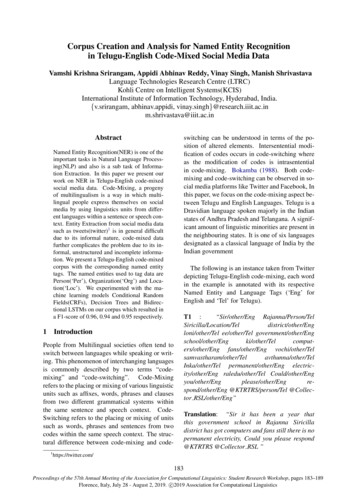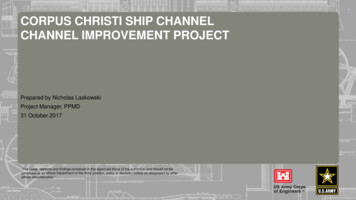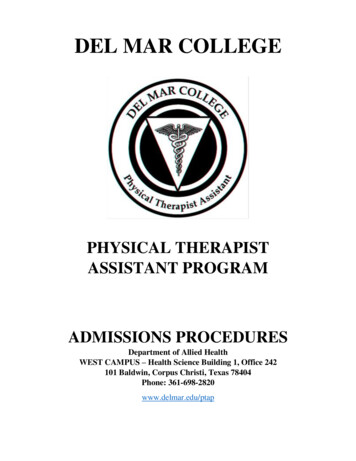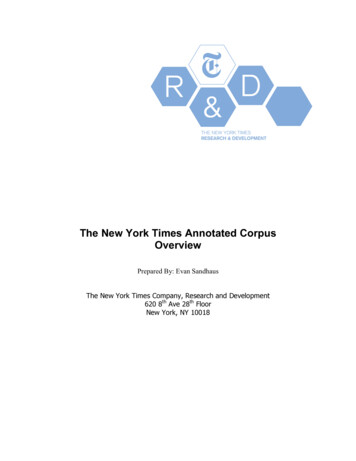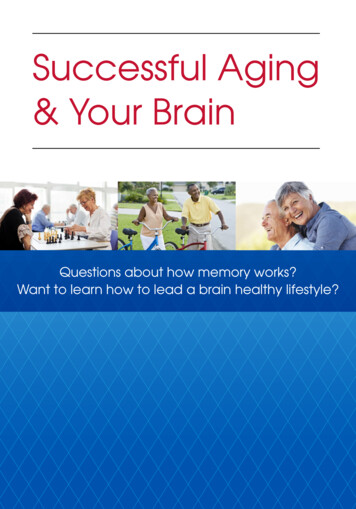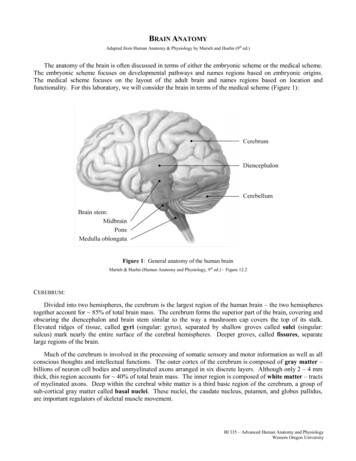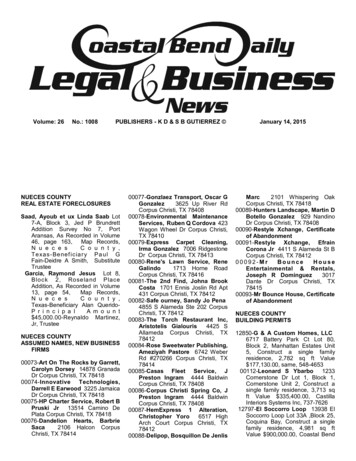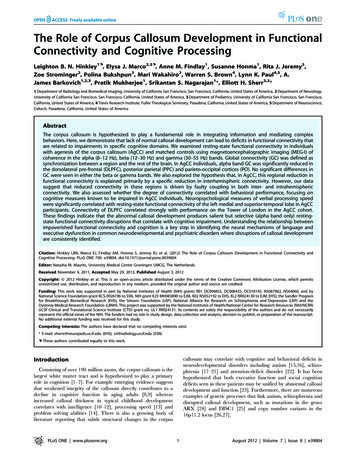
Transcription
The Role of Corpus Callosum Development in FunctionalConnectivity and Cognitive ProcessingLeighton B. N. Hinkley1., Elysa J. Marco2,3., Anne M. Findlay1, Susanne Honma1, Rita J. Jeremy3,Zoe Strominger2, Polina Bukshpun2, Mari Wakahiro2, Warren S. Brown4, Lynn K. Paul4,5, A.James Barkovich1,2,3, Pratik Mukherjee1, Srikantan S. Nagarajan1*, Elliott H. Sherr2,3*1 Department of Radiology and Biomedical Imaging, University of California San Francisco, San Francisco, California, United States of America, 2 Department of Neurology,University of California San Francisco, San Francisco, California, United States of America, 3 Department of Pediatrics, University of California San Francisco, San Francisco,California, United States of America, 4 Travis Research Institute, Fuller Theological Seminary, Pasadena, California, United States of America, 5 Department of Neuroscience,Caltech, Pasadena, California, United States of AmericaAbstractThe corpus callosum is hypothesized to play a fundamental role in integrating information and mediating complexbehaviors. Here, we demonstrate that lack of normal callosal development can lead to deficits in functional connectivity thatare related to impairments in specific cognitive domains. We examined resting-state functional connectivity in individualswith agenesis of the corpus callosum (AgCC) and matched controls using magnetoencephalographic imaging (MEG-I) ofcoherence in the alpha (8–12 Hz), beta (12–30 Hz) and gamma (30–55 Hz) bands. Global connectivity (GC) was defined assynchronization between a region and the rest of the brain. In AgCC individuals, alpha band GC was significantly reduced inthe dorsolateral pre-frontal (DLPFC), posterior parietal (PPC) and parieto-occipital cortices (PO). No significant differences inGC were seen in either the beta or gamma bands. We also explored the hypothesis that, in AgCC, this regional reduction infunctional connectivity is explained primarily by a specific reduction in interhemispheric connectivity. However, our datasuggest that reduced connectivity in these regions is driven by faulty coupling in both inter- and intrahemisphericconnectivity. We also assessed whether the degree of connectivity correlated with behavioral performance, focusing oncognitive measures known to be impaired in AgCC individuals. Neuropsychological measures of verbal processing speedwere significantly correlated with resting-state functional connectivity of the left medial and superior temporal lobe in AgCCparticipants. Connectivity of DLPFC correlated strongly with performance on the Tower of London in the AgCC cohort.These findings indicate that the abnormal callosal development produces salient but selective (alpha band only) restingstate functional connectivity disruptions that correlate with cognitive impairment. Understanding the relationship betweenimpoverished functional connectivity and cognition is a key step in identifying the neural mechanisms of language andexecutive dysfunction in common neurodevelopmental and psychiatric disorders where disruptions of callosal developmentare consistently identified.Citation: Hinkley LBN, Marco EJ, Findlay AM, Honma S, Jeremy RJ, et al. (2012) The Role of Corpus Callosum Development in Functional Connectivity andCognitive Processing. PLoS ONE 7(8): e39804. doi:10.1371/journal.pone.0039804Editor: Natasha M. Maurits, University Medical Center Groningen UMCG, The NetherlandsReceived November 4, 2011; Accepted May 29, 2012; Published August 3, 2012Copyright: ß 2012 Hinkley et al. This is an open-access article distributed under the terms of the Creative Commons Attribution License, which permitsunrestricted use, distribution, and reproduction in any medium, provided the original author and source are credited.Funding: This work was supported in part by National Institutes of Health (NIH) grants R01 DC004855, DC006435, DC010145, NS067962, NS64060, and byNational Science Foundation grant BCS-0926196 to SSN, NIH grant K23 MH083890 to EJM, K02 NS052192 to EHS, KL2 RR024130 to EJM, EHS), the Sandler Programfor Breakthrough Biomedical Research (EHS), the Simons Foundation (LKP), National Alliance for Research on Schizophrenia and Depression (LKP) and theDystonia Medical Research Foundation (LBNH). This project was supported by the National Institutes of Health/National Center for Research Resources (NIH/NCRR)UCSF-Clinical and Translational Science Institute (CTSI) grant no. UL1 RR024131. Its contents are solely the responsibility of the authors and do not necessarilyrepresent the official views of the NIH. The funders had no role in study design, data collection and analysis, decision to publish, or preparation of the manuscript.No additional external funding was received for this study.Competing Interests: The authors have declared that no competing interests exist.* E-mail: sherre@neuropeds.ucsf.edu (EHS); sri@radiology.ucsf.edu (SSN). These authors contributed equally to this work.callosum may correlate with cognitive and behavioral deficits inneurodevelopmental disorders including autism [15,16], schizophrenia [17–21] and attention-deficit disorder [22]. It has beenhypothesized that both executive function and social cognitiondeficits seen in these patients may be unified by abnormal callosaldevelopment and function [23]. Furthermore, there are numerousexamples of genetic processes that link autism, schizophrenia anddisrupted callosal development, such as mutations in the genesARX [24] and DISC1 [25] and copy number variants in the16p11.2 locus [26,27].IntroductionConsisting of over 190 million axons, the corpus callosum is thelargest white matter tract and is hypothesized to play a primaryrole in cognition [1–7]. For example emerging evidence suggeststhat weakened integrity of the callosum directly contributes to adecline in cognitive function in aging adults [8,9] whereasincreased callosal thickness in typical childhood developmentcorrelates with intelligence [10–12], processing speed [13] andproblem solving abilities [14]. There is also a growing body ofliterature reporting that subtle structural changes in the corpusPLoS ONE www.plosone.org1August 2012 Volume 7 Issue 8 e39804
Callosal Connectivity and Executive FunctionIndividuals with agenesis of the corpus callosum (AgCC),including those with complete (cAgCC) and partial (pAgCC)absence of the corpus callosum, present a unique opportunity forunderstanding the relationship between the development ofcallosal integrity and cognitive processing. For instance, there isemerging evidence indicating that even in individuals in thenormal IQ range, anatomically overt abnormalities of callosaldevelopment (including its complete absence) lead to deficits incognitive abilities. Primarily, individuals with AgCC show deficitsin both problem solving abilities [28,29] and processing speed[30]. Preliminary evidence suggests that impairments in domainssuch as abstract reasoning [31,32], verbal fluency and secondorder linguistic deficits [7,31,33] as well as social cognition [34–36] may indeed be secondary to core problem solving andprocessing speed deficits in these individuals [32,37].Collectively, these findings suggest that an intact corpuscallosum contributes significantly to efficient executive function,or the execution and maintenance more generally of complexcognitive abilities [38]. However, it is not clear if the failure ofcorpus callosum development simply disrupts interhemisphericcoupling or if there is a selective vulnerability in callosal dysgenesisto certain cognitive domains that are dependent on efficientinterhemispheric communication. Moreover, because the underlying disruptions in brain development and cerebral connectivitythat lead to AgCC may also alter intrahemispheric connectivity, itis possible that AgCC individuals have additional cognitive deficitsthat are caused by impairment of intrahemispheric connectivity.Our prior work showing that the cingulum bundle is smaller andhas a lower fractional anisotropy in AgCC individuals supports thismore nuanced hypothesis [39]. The study of individuals withAgCC informs our understanding of how structural connectivityacross the hemispheres contributes to other, more broadly defined,neurodevelopmental disorders thought to result from decreasedlong-range interactions in the brain [16,23,40].To address these questions, we used magnetoencephalography(MEG) to examine resting state functional connectivity in AgCCindividuals and age- and IQ-matched healthy controls. MEGpermits the imaging of brain activity in the sub-millisecond timescale by measuring magnetic field changes on or near the scalpsurface. Whole brain activity can be estimated from MEG sensordata using source reconstruction algorithms that allow one tooverlay cortical oscillatory activity onto subjects’ anatomicalimages in order to localize changes in cortical oscillations tospecific brain regions. This process is referred to as magnetoencephalographic imaging (MEG-I). Advances in statistical signalprocessing have improved the spatiotemporal resolution of MEG-Iand have also more recently been adapted to interrogatefunctional interactions in cortical oscillatory activity across brainregions and frequency ranges [41–43]. This study capitalizes uponthese advances by using MEG-I and novel methods for assessingfunctional connectivity to address how callosal dysgenesis in AgCCcontributes to compromised cognitive processing.In the present study, we measured MEG-I resting-stateconnectivity to test the hypothesis that AgCC individuals havedecreased functional connectivity in comparison to age and IQmatched controls. It has been proposed that ipsilaterally projectingfibers that develop in callosal agenesis patients (i.e. Probst bundles)[44] selectively aid in the within-hemisphere transfer of information in the absence of fully formed cross-hemispheric tracts.Therefore, we further address whether connections within a singlehemisphere (intrahemispheric connectivity) are increased as acompensation for diminished cross-hemisphere (interhemispheric)connections. We also hypothesize that individuals with completeAgCC (cAgCC) will have diminished interhemispheric coherencePLoS ONE www.plosone.orgrelative to individuals where partial (pAgCC) callosal fragmentsremain that could serve interhemispheric transfer. Finally, wepropose that the degree of resting-state functional connectivitywill, in individuals with AgCC, correlate with performance incognitive domains known to be affected in these individuals:problem solving [32] and verbal processing speed [30].Materials and MethodsEthics StatementThis study was approved by the UCSF Committee on HumanResearch, and all experiments were conducted in accordance withthe Declaration of Helsinki. All participants gave written informedconsent to participate. Additional written consent was obtainedfrom the parents/guardians of the participants involved who wereunder the age of 18.ParticipantsThis study involved 18 patients with agenesis of the corpuscallosum (AgCC) aged 17–57 years (mean age 31, SD 12.1)recruited through the UCSF Comprehensive Center for BrainDevelopment (Tables 1 and 2). Six of the participants were female(30%), four were left handed (22%) and two were ambidextrous(11%). The AgCC cohort had a mean FSIQ of 100 (range 77–129;SD 13.7). Of the 18 AgCC patients, nine had complete agenesisof the corpus callosum and nine had partial agenesis of the corpuscallosum. The FSIQ for pAgCC was 101 (range 77–129;SD 16.2) and for cAgCC was 98 (range 78–112; SD 13.7).Eighteen right-handed healthy control (HC) participants (tenfemale) matched for age and IQ were recruited from the greaterSan Francisco Bay Area. The mean age for this sample was 29years (range 19–51 years, S.D. 11) and the mean FSIQ was 105(range 89–115, S.D. 7.1.) There was no significant differencebetween age or FSIQ for the AgCC cohort and controls.Furthermore, there was no significant difference between thepAgCC and cAgCC age cohorts on age or FSIQ (all p.0.05). Thediagnosis of AgCC was made based on radiographic review by atleast two of these authors based on published criteria (E.H.S,A.J.B. and P.M) [45]. All participants were assessed with acomprehensive research battery, including: medical history,physical and neurological examination, genetic testing, neuropsychological evaluation, and diagnostic MR imaging.Neuropsychological TestingBoth individuals with AgCC and healthy controls wereevaluated with either the Wechsler Adult Intelligence Scale-III(WAIS-III) [46] or the Wechsler Abbreviated Scale of Intelligence(WASI) [47]. All subjects were administered the Delis-KaplanExecutive Function System (D-KEFS), an executive functionbattery that probes performance in multiple cognitive domainsincluding processing speed and problem solving [48]. All but oneof the behavioral evaluations were conducted or supervised by asingle developmental psychologist who was not informed ofdiagnosis (R.J.J.). The behavioral testing on a single AgCCparticipant was conducted in the laboratory of Dr. Warren Brown.One AgCC participant did not receive a full behavioral evaluationand was excluded from correlation analyses with the behavioraldata. Two composite measures from within the D-KEFS wereselected a priori for correlations with the functional connectivitydata: the Combined Color Naming and Word Reading verbalprocessing speed (VPS) measure from the Color-Word Interference Test (CWIT-VPS) and the Total Achievement problemsolving (PS) measure from the Tower Test (TT-TA). Although afull D-KEFS was obtained in each participant, we chose these2August 2012 Volume 7 Issue 8 e39804
Callosal Connectivity and Executive FunctionTable 1. Complete Agenesis of the Corpus Callosum Cohort Characterization.IDVIQPIQP/CCC detailsPB AC HC CO WMOther MRI findings:MedicationsOther diagnosis:10549182CAbsent Nl2–MildnoneLevetiracetamGabapentinShapiro SyndromeADHD, Depression14268691CAbsent Nl2 Mildperiventricular heterotopiaEscitalopram12408383CAbsent Nl2 ModnoneNoneNone106299109CAbsent Nl2 Modperisylvian polymicrogyria &posterior fossa arachnoid cystNoneDepression & AuditoryHallucinations1258–5102104CAbsent Lg2 MildnoneNoneNone119890118CAbsent Nl2 Severeperiventricular heterotopia &right cerebellar dysplasiaNoneASD1516105111CAbsent Nl2 Modabnormal medial temporalcortical foldingNoneNone1202112109CAbsent Lg2 ModnoneNoneNone1386114107CAbsent Lg2 Severe/ModNoneLamictal, concertaAsperger’s, ADHD,anxiety, depressionAbbreviations: PIQ performance IQ; VIQ verbal IQ; P/C (P)artial or (C)omplete callosal agenesis; PB probst bundle; AC anterior commisure size; HC presenceof hippocampal commisure; CO presence of colpocephaly; WM degree of white matter reduction (most affected area); P partial; C complete; present; 2 absent; Sm small; Nl normal; Lg large; n/a not 039804.t001relationships between these neuropsychological measures andfunctional connectivity.measures as they probe domains of cognitive function that, basedon ongoing work in our laboratory, appear to be central toobserved behavioral impairments in patients with AgCC. TheCWIT-VPS score is representative of basic processing speed(CWIT) [48] and this composite measure from the D-KEFS isreported to reflect processing speed deficits in individuals withcallosal agenesis [37]. For this analysis, a composite score (sum ofage-scaled scores for Color Naming and Word Reading) wasexamined as a verbal processing speed measure. The Tower Test(TT-TA score) is a modification of the Tower of London task inthe D-KEFS designed to probe processes of problem solvingincluding spatial planning and rule learning [37]. Both the CWITVPS and TT-TA are age-scaled continuous variables with a meanof 10 and a standard deviation of 3; higher scores denote betterperformance.The D-KEFS behavioral measures were analyzed with STATAversion 10 using a one-way MANOVA with corpus callosumstatus (intact, pAgCC, cAgCC) as the independent multi-levelvariable and the participants’ score on the TT-TA and CWITVPS as the continuous dependent measures. The one-wayMANOVA comparing an overall effect of group (HC, pAgCC,cAgCC) by test (TT-TA and CWIT-VPS) revealed no statisticalgroup differences (Pillai’s Trace 0.06, F(4,52) 0.42, p 0.7). Thegroup means were lower and variance was greater in the AgCCcohort for both TT-TA (HC: mean 10.5, SD 1.58; AgCC:mean 9.18, SD 2.96) and CWIT-VPS (HC: mean 9.61,SD 1.33; AgCC: mean 9.06, SD 2.70) scores when compared to healthy controls. Although we do not observe significantdifferences in these measures within our sample, in a similaranalysis with a larger cohort that included subjects from this study,there are indeed significant differences in problem solving andprocessing speed in AgCC [30,32]. Two factors could contributeto our observation of a lack of significant difference in theseneuropsychological measures. First, perhaps it is our smallersample size (n 18) compared to the larger cohort study (n 36;[37]). Second, our sample includes more high-functioningindividuals who are more tolerant of brain imaging studies leadingto higher performance in our sample. Nevertheless, findings fromthe larger cohort study motivates the choice of examiningPLoS ONE www.plosone.orgMRI AcquisitionStructural (T1-weighted) anatomical images were acquired forsource space reconstruction, data visualization and second-levelgroup analyses. Scanning was performed using a 3.0T GE Trioscanner installed at Surbeck Lab for Advanced Imaging at theUCSF China Basin campus. For each subject, a 3D-FSPGR highresolution MRI was acquired (160 1mm thick slices; matrix 2566256, TE 2.2 ms, TR 7 ms, flip angle 15u).Magnetoencephalography RecordingsData were collected from patients and controls using a wholehead biomagnetometer (MEG International Services, Coquitlam,British Columbia, Canada) containing 275 axial gradiometers at asampling rate of 1200Hz. For registration, coils were placed at thenasion and 1 cm rostral to the left and right preauricular pointsangled toward the nasion in order to localize the position of thehead relative to the sensor array. These points were later coregistered to a high-resolution structural MR image through alinear affine transformation between fiducial points, MEG devicecoordinates and MRI coordinates (spherical single-shell headmodel). Scan sessions where head movement exceeded 0.5 cmwithin a run were discarded and repeated. Participants were lyingin a supine position and instructed to remain awake with their eyesclosed during a four-minute continuous recording session.Data ReconstructionFrom the four minute spontaneous (awake) recording session, asingle, contiguous 60s artifact-free segment of the MEG data wasselected for analysis. The full recording session was not used asnearly all participants had at least one noisy, transient (,60s)segment of the data that was excluded from the analysis.Furthermore, previous investigations have determined that this60s window provides reliable, consistent power for reconstructionof brain activity from the resting-state MEG data [41–43].Artifact-free segments were identified qualitatively through avisual inspection of the sensor data, where only segments without3August 2012 Volume 7 Issue 8 e39804
PLoS ONE PP/CPosterior genu, anteriorbody present onlyAbsence of posterior bodyAbsence of rostrum, inferiorgenu hypoplastic, posteriorbody and splenium absentAbsent inferior genu,posterior body and spleniumAbsent rostrum, superiorgenu, body, and spleniumAbsent rostrum, inferiorgenu, thin anterior body,absent spleniumAbsent superior genu, bodyand spleniumdysplastic with absent genu,superior body, and spleniumAbsent rostrum, superiorgenu, body and spleniumCC detailsLgSmNl 2––Lg2NlLgLgNl ACPB 2 22– – COn/a2–– rge interhemispheric glioma,Large ventriclessmall ventriclesnonenonenoneabnormal medial temporal corticalfoldinginterhemispheric cystNoneNoneLithium, SeroquelNoneNoneNoneNoneNonepolymicrogyria, periventricularValproic Acid Prozacheterotopia, & interhemispheric cystOther MRI findings:TremorNoneHearing impairedNoneMigraineMigraineNoneDepression, MigraineASD; OCD; EpilepsyOther diagnosis:Abbreviations: PIQ performance IQ; VIQ verbal IQ; P/C (P)artial or (C)omplete callosal agenesis; PB probst bundle; AC anterior commisure size; HC presence of hippocampal commisure; CO presence of colpocephaly;WM degree of white matter reduction (most affected area); P partial; C complete; present; 2 absent; Sm small; Nl normal; Lg large; n/a not 514191101384100771096–01477VIQIDTable 2. Partial Agenesis of the Corpus Callosum Cohort Characterization.Callosal Connectivity and Executive FunctionAugust 2012 Volume 7 Issue 8 e39804
Callosal Connectivity and Executive Functionexcessive scatter (signal amplitude .10 pT) due to eyeblink,saccades, head movement or EMG noise were selected foranalysis. Source-space reconstructions and functional connectivitymetrics were computed using the Nutmeg software suite (http://nutmeg.berkeley.edu). In each subject, a local sphere wasgenerated based on registration between each MEG sensor andthe head surface obtained from the subject’s T1-weightedstructural MRI, resulting in a multiple local-sphere head model[49]. From this head model, a whole-brain, subject-specific leadfield (forward kernels), i.e. the expected sensor data for unit sourceactivity in each voxel and orientation, was computed and used forinverse modeling with adaptive spatial filtering and subsequentfunctional connectivity analysis.MEG sensor data were downsampled to 600Hz, bandpassfiltered (fourth-order Butterworth filter) and reconstructed insource space using a minimum-variance adaptive spatial filteringtechnique [50–51]. This approach provides a power estimate ateach element (voxel) derived through a linear combination of aspatial weighting matrix (itself calculated through a forward-fieldand spatial covariance matrix) with the sensor data matrix.Reconstructions were not isolated to the cortical surface. Instead,source activity was reconstructed in each voxel within the MRIvolume, assuming that at each voxel the source is a dipole withunknown orientation using a vector-source field formulation.While voxel power is estimated in each orientation, powerestimates were obtained by summing power across all sourceorientations.For each subject, power spectrograms of this 60s epoch of thesensor data were generated using FFT (1–20 Hz, 1024 sampleswith a frequency resolution of 1.17 Hz) in order to select a subjectspecific alpha band (identified as the greatest power density withinthe 8–12 Hz range). A peak in the alpha band was easilyidentifiable from this amount of data in both AgCC patients andcontrols (Figure 1). Visual inspection of the spectrum revealed noother clearly discernable peaks in the magnetoencephalogramsensor recordings at frequencies greater than 12 Hz. Althoughpeaks in the theta range (4–8 Hz) were discernable in somesamples, it was not consistent enough for us to perform subjectspecific band selection (as was done for alpha). Therefore, forfrequency ranges outside of alpha, we used fixed width frequencybands applied to each subject for our functional connectivityreconstructions in both the patient and control groups for theta(fixed width of 4–8 Hz), beta (fixed width of 12–30 Hz) andgamma (fixed width of 30–55 Hz) frequency bands.Global Connectivity AnalysisFunctional connectivity was estimated using imaginary coherence (IC), a metric that overcomes estimation biases in MEGsource data by isolating non-zero time-lagged interactions [52].First, we estimate imaginary coherence between two voxels foreach frequency within the range of interest (e.g. theta, alpha, beta,gamma). We then take the absolute value of the imaginarycoherence across these frequencies within the range of interest andaverage them to get a since IC value for each voxel pair [41].Global connectivity (GC) at each location was derived byaveraging across all Fisher’s Z-transformed IC values betweenthat voxel and all remaining elements (voxels) in the reconstruction. For a second-level group analysis, each individual subject’sanatomical T1-weighted MRIs were spatially normalized to theMNI MRI template using standardized procedures [53] in 2). This processcreated a non-linear transformation matrix for each subject that,was then applied to each individual subject’s GC map [41,43].This non-linear transformation is only used at the group analysislevel following source reconstruction of each individual subject’sMRI coordinates with subject-specific lead fields, in order to bringall source reconstruction images to a common template (MNI)coordinate system. All the coordinates we report in the paper arein this space.A comparison between the AgCC connectivity maps relative toHC connectivity was performed using a non-parametric unpairedtwo-tailed t-test [54–55]. Due to the limited sample size in eachseparate group, voxel-wise comparisons of GC between thepAgCC (n 9) and cAgCC (n 9) groups were not conducted.Intra/Interhemispheric Connectivity AnalysesA post-hoc analysis to assess within intrahemispheric connectivity and interhemispheric connectivity was conducted usingregion of interest (ROI) analysis. The ROIs were defined based onthe difference in the GC maps of the total AgCC group vs. HC.The euclidian midpoint or center of mass was computed fromeach significantly different cluster and a seed voxel (20 mm) wasgenerated at this location for each subject. Global functionalconnectivity (connections between the seed voxel and all othervoxels in a given hemisphere) was averaged across each subject forthe connections of the ROI within (voxels ipsilateral to ROI) andacross (voxels contralateral to ROI) hemispheres. This type of datareduction gives us a single point value (GC average) for a singleseed of its connections either within the ipsilateral hemipshere(intrahemispheric connectivity) or between that seed and all othervoxels in the contralateral hemisphere (interhemipsheric connectivity). Differences between and within groups were assessed usinga 26262 mixed-effects ANOVA varying group (HC vs. AgCC),hemisphere (left vs. right) and connection type (intrahemisphericvs. interhemispheric). Given the reduced sample size (n 9 in eachgroup) when the AgCC cohort is split into pAgCC and cAgCCsubtypes, we also conducted an exploratory planned comparisondirectly comparing the intra- and interhemsipheric connectionsbetween the two groups using two-tailed unpaired t-tests.ReliabilityIn order to derive an estimate of within-session reliability ofresting-state functional connectivity analyses using IC, we calculated the intra-class correlation coefficient (ICC; [56]) between twoartifact-free, sixty-second epochs within a single functional run.ICCs were computed at each voxel across four frequency bands(theta, alpha, beta, gamma). For the alpha band, good test-retestreliability scores (mean ICC 0.56) were observed. For the thetaand beta bands, fair test-retest reliability scores (theta, meanFigure 1. Averaged power spectral density estimates derivedfrom MEG sensors separately for the healthy control (HC; ingreen), partial (pAgCC; in blue) and complete agenesis of thecorpus callosum (cAgCC; in red) groups during a single PLoS ONE www.plosone.org5August 2012 Volume 7 Issue 8 e39804
Callosal Connectivity and Executive FunctionGC 0.0435,SD 0.0074;rightmeanGC 0.0525,SD 0.0058). In addition, there were two regions that wereunderconnected unilaterally in the AgCC cohort. In the righthemisphere, a distinct region of the right MFG over Brodmann’sArea 6 (p,0.01, FWE corrected; AgCC mean GC 0.0454,SD 0.0053; HC mean GC 0.0543, SD 0.0074) and a regionof the insula (p,0.05, FWE corrected; AgCC mean GC 0.0324,SD 0.0076; HC mean GC 0.0429, SD 0.0098) were underconnected (Figure 2C, Table 3). Interestingly, there were nooverconnected regions in the AgCC group in comparison tomatched controls, even at relaxed (uncorrected) statistical thresholds.ICC 0.36; beta, mean ICC 0.34) were observed. For thegamma band, poor within-session test-retest reliability wasobserved (mean ICC 0.27).Behavioral Data Analyses and Functional ConnectivityCorrelationsTo explore the relationship between connectivity and cognition,we did a voxel-wise Pearson’s r correlation between GC maps andage-scaled scores from the D-KEFS battery. Data was collapsedacross pAgCC and cAgCC groups to maximize power in ouranalyses.Multiple Comparisons CorrectionResting-State Global Functional ConnectivityComparison: Beta/Gamma BandFor all voxelwise fcMEG-I analyses (including both the wholebrain group comparison and correlations with neuropsychologicalmetrics) we performed a multiple comparisons correction using aFalse Discovery Rate (FDR) set at 10%. When effects weresignificant, we explored how robust these effects were by applyingmore stringent thresholds, including a lower FDR q-value (either5% or 1%), or a Family-Wise Error (FWE) rate. We report themost conservative multiple comparisons correction (either FDR orFWE) still producing significant effects here.No significant difference in beta-band imaginary coherence wasidentified between the two groups (all p.0.05 corrected). Likewise,no significant differences were identified for a group comparisonbetween HC and AgCC for the resting-state gamma reconstructions (all p.0.05 corrected).Intrahemispheric and Interhemispheric ConnectivityIn AgCC individuals, neuroanatomical changes extend beyondjust an
California, United States of America, 4Travis Research Institute, Fuller Theological Seminary, Pasadena, California, United States of America, 5Department of Neuroscience, Caltech, Pasadena, California, United States of America Abstract The corpus callosum is hypothesized to play a fundamental role in integrating information and mediating complex


